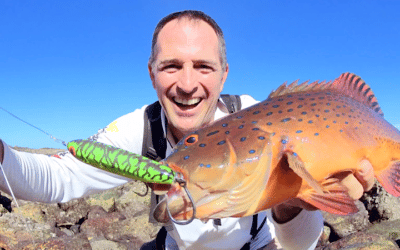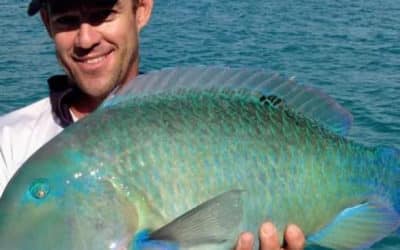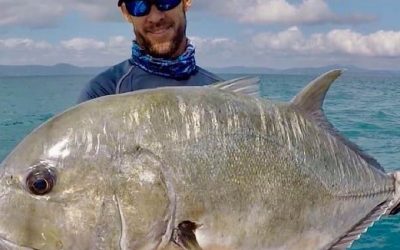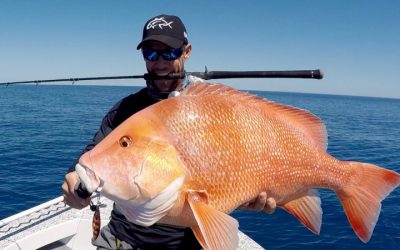It’s not necessary to travel all the way to the reef to tangle with monstrous giant trevally. Today’s guest Jack Avery shares his tips for getting among thug GT’s around the islands of the Whitsundays area.
A Sportsfisher’s Guide To Lure Fishing Airlie Beach And The Whitsundays
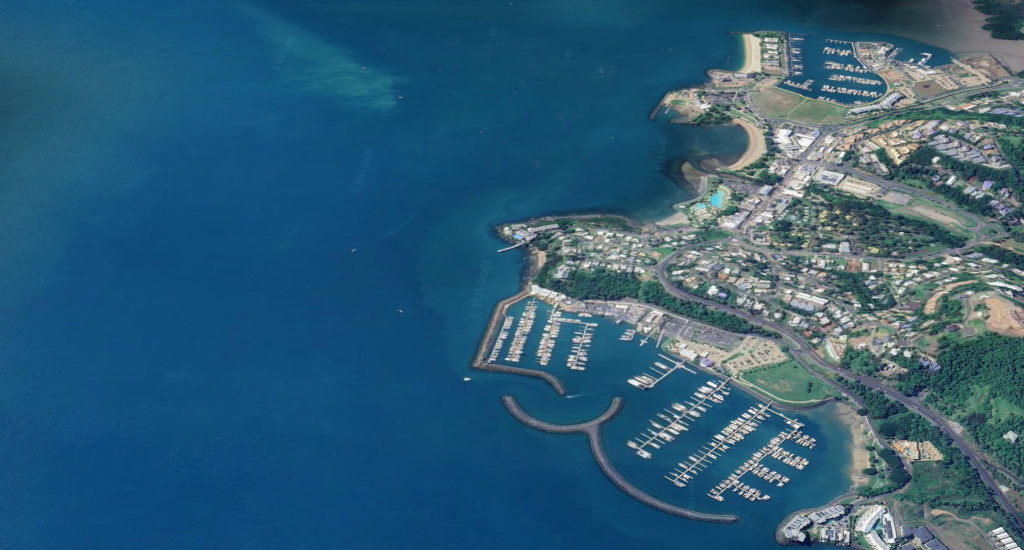
If you’re after some of the best sportfishing experiences Australia has to offer, Airlie Beach should be your go-to destination. Known for its vibrant marine life and stunning coastal scenery, Airlie Beach isn’t just a gateway to the Whitsundays—it’s a top spot for anglers aiming to test their skills or simply enjoy a day out on the water. Whether you prefer the thrill of casting off the shore or the adventure of heading into deeper waters, this guide covers everything you need to know about lure fishing across various local spots. From beginner tips to expert tactics, we’ve got you covered. Let’s get you set up for a memorable fishing trip!
Land-based fishing in Airlie Beach
Whether you’re fishing the sandy beaches or rocky outcrops of Airlie Beach, you can expect to hook species like barramundi, mangrove jack, fingermark bream, threadfin salmon and even bread and butter species like whiting, and flathead.
A medium action rod with 10-20 lb test line is versatile enough for most shore shore fishing around Airlie. I recommend the Jabbers Urban Beats Deft Flicker, with a 3000 size spin reel, a 150 size baitcast, depending on which rod you choose. Don’t forget some 50lb leader and a selection of surface poppers, soft plastic paddletails and soft prawns in 4-5″ sizes.
7 Land-Based Fishing Spots in Airlie Beach
Discover some of the best spots around Airlie Beach for shore fishing:
- Abell Point Marina – The marina has plenty of accessible shorelines and rockwalls, many of them providing access to reasonably deep water with fish holding structure that’s fishable in any conditions. Worth a look for jewfish and mangrove jacks. Also worth a shot for squid under the lights at night.
- Shute Harbour – There’s a public fishing pontoon at Shute Harbour that’s perfect for those targeting mackerel and trevally. High speed metal lures are a good choice here, but poppers, hard bodies or soft plastic paddletails are also worth trying.
- VMR Rock Wall – Located to the left of the boat ramp, this is a high tide spot for large golden trevally and queenfish. Once again, poppers and stickbaits will do the damage on these species.
- Conway & Wilsons Beaches – A short 35 minute drive from Airlie, this area fishes well for barramundi and threadfin salmon along the rocky shorelines. Take plenty of weedless paddletails in the 5-6″sizes, along with a few hard body jerkbaits. Be especially wary of crocodiles in this area.
- Boathaven Beach – A great little Airlie Beach fishing spot for those chasing whiting and flathead. Or, get a little more adventurous and climb out on the rockwalls at either end of the beach for a shot at mackerel, queenfish and trevally on poppers and metal lures.
- Marine Club Rockwall – A popular spot among locals where bouncing around some weedless soft plastic paddletails or soft prawns could see you catch fingermark, jewfish and mangrove jack.
- Dingo Beach – Just shy of an hours drive north of Airlie Beach, Dingo beach has to be one of the most pictureaque fishing spots imagineable. Best results come to those willing to walk or 4wd to the less accessible headlands, where a good cast will put your popper over ground where coral trout, sweetlip and a range of other “reefies” are on the cards.
Fishing Airlie Beach From A Boat
For the sportfisher, the fishing in Airlie Beach and the Whitsundays area is, quite simply, off the charts. The multitude of opportunities can be somewhat bewildering, so let’s break it down to a few starting points. From there you’ll need to research, explore and find your own way to the plentiful fishing throughout this region.
- The Paddock: North of Hook and Hayman Island and well offshore is a large expanse well-known to game fishers as “The Paddock”. You’ll need a decent sized boat and fair weather to fish here, as it’s a bit of a journey and the area is exposed and experiences strong currents. It’s a great place to throw large poppers and stickbaits at giant trevally, or to target a range of pelagics, especially in the cooler months.
- Minstrel Rocks: A small rock outcrop with relatively shallow water and fringing reef, Minstrel Rocks is a great winter-time destination for those fishing Airlie Beach for Spanish mackerel. Trolling the reef fringes is effective, but throwing poppers and stickbaits when fish are surface feeding can be super exciting.
- Hook Passage: The stretch of water between between Whitsunday Island and Hook Island is one of Airlies worst-kept secrets when it comes to bouncing jigs and soft plastics for sweetlip, spangled emperor, and coral trout. This area has both reef flats and dropoffs that are productive year-round, despite their popularity.
- Apostle Bay: Head for this area at the northwest of Whitsunday Island during the warmer months to target coral trout, spangled emperor, and other reef fish. Slow pitch jigging is the preferred approach here, although octo style jigs can also be effective.
- Long Island Edges: For me, an Airlie Beach fishing trip wouldn’t be complete without a visit to Long Island. It’s not far offshore, and an easy 25km run to the northern end of the island and once there, there’s sheltered water under most conditions. In good conditions the area from Pelican Island south, on the Eastern side of Long Island has plenty of fringing reefs that produce giant trevally, queenfish, cod, and coral trout. Poppers and stickbaits are heaps of fun through this area.
- Double Cone Islands: Heading north out of Airlie Beach are the Double Cone Islands, noted for shallow reef fishing for coral trout and trevally. Look for bommies and focus on periods with good tidal movement for best results.
- T-Line Reef: T-Line is not one of Airlie Beach’s most accessible spots. It’s around 100 nautical miles east of Mackay and requires a large, seaworthy boat and good weather. One there, it’s by all accounts a very special place where poppers can be cast into blue holes for massive giant trevally. It’s highly visual, exciting fishing, but requires a good knowledge of the systems and a respect for tidal currents and weather.
Airlie Beach Fishing By Season
Central and north Queensland don’t experience four distinct seasons in the same sense as the southern states, but rather a warmer, more humid “wet season” that runs from around November to April, and a cooler “dry season from May through October. Nonetheless, for the purposes of discussing fishing patterns, it’s convenient to use the traditional four seasons framework, so we’ll run with that.
Fishing in Airlie Beach During Spring
Rising water temperatures during the Spring months invigorate a lot of fish species, particularly river and estuarine species such as barramundi and mangrove jack. Consistent south easterly trade winds are often still blowing during September, but these transition to easterly and north easterly as the season wears on, becoming more variable in strength and direction. This is a great time to fish the islands and pick the weather windows to go out wider to the outer reef. Temperatures and humidity are more comfortable than during the wet season and most of the reef and island species will be cooperative.
Airlie Fishing In Summer
Moving into the wet season, the easterly and north easterly winds kick in. This is a time of dead calm days and howling gales with much less consistent wind than the cooler months. It’s also the time of hot, humid weather, monsoons and cyclones, so care must be taken to pick the right conditions, particularly if you’re planning to make the long run out to the outer reef. Most reef species will chew right through the summer, and it’s also a great time for barramundi, mangrove jack and threadfin in the rivers and coastal areas. Mind the closed season on barramundi.
Autumn Fishing Options
The transition from the wet to dry seasons is one of the best times to fish. Barra will be feeding on headlands and all along the coast, as well as the rivers and estuaries. Mangrove jack and threadfin will continue to feed in this period also. This is also a time when pelagic species such as queenfish and Spanish mackerel become more prevalent, although the return of south easterly trade winds later in the season can make it uncomfortable to get around.
Fishing Airlie During Winter
Lower temperatures and humidity make things more comfortable for anglers but consistent south easterly trade winds can make opportunities for offshore and reef fishing few and far between. The best option is to tuck in behind a headland or island, take advantage of the many inlets, bays and recesses along this coastline. This is a great time to target GT, and reef species along the fringing reefs on inshore islands. The barra and jacks will be a little quieter, but can still be caught with a little patience and persistence. Look for pockets of warmer water for best results.
ALF Episodes About Fishing In The Whitsunday’s And Airlie Beach Area
Episode 377: Whitsundays Land-Based Coral Trout With Andy Thomsen
Coral trout from the shore? No problem! Today’s guest Andy Thomsen is happy share his secrets for targeting colourful, tasty fish from the stones.
Episode 354: Airlie Beach Tuskfish With Tony Bygrave
Fishing for Tuskfish with lures on the flats? Why not? Tony Bygrave shares his tips for a very special type of fishing.
Episode 246: Whitsundays Giant Trevally With Tony Bygrave
Giant trevally fishing is a tough business and Whitsundays angler Tony Bygrave has been perfecting the art for over 20 years. In this episode To0ny shares his thoughts on targeting Island GT’s from his home at Airlie Beach.
Episode 162: Airlie Beach Red Emperor With Tony Bygrave
Jigging for red emperor is not an easy task, but in recent years a handful of enthusiasts are starting to get some consistency in their results. Airlie Beach angler Tony Bygrave is one of those and shares a bunch of tips in today’s episode.



